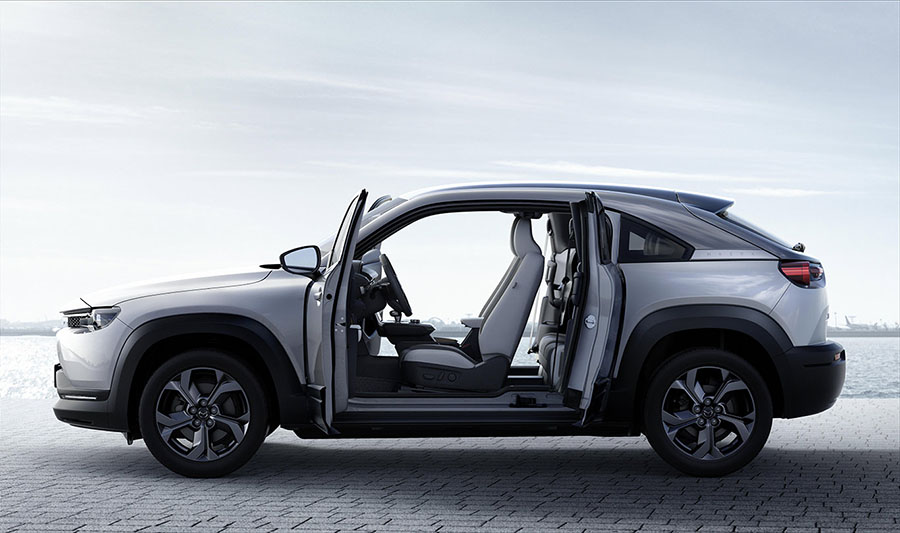Mazda often follows an idiosyncratic technology strategy: For a long time, the Japanese didn’t want to build an electric car. Now they do it anyway – and do some things differently with the MX-30.

The first impression: At first glance, the Mazda MX-30 looks like a normal compact SUV. A closer look reveals what is special: Oppositely hinged doors without a B-pillar. This is already the case with the electric BMW i3 or the Mazda RX-8 sports car, but it’s new with the SUV.
The manufacturer says: “Mazda likes to go its own way,” says company spokesman Jochen Münzinger. In fact, the Japanese often pursue a technology strategy that deviates from the mainstream. Mazda was the only brand to remain loyal to the Wankel engine – the unit in which the piston rotates. The self-igniting petrol engine is also a special feature of Mazda. After two decades of research, it went into series production last year.
Electric cars are another issue where Mazda has been swimming against the tide for a long time. The company did not even offer a hybrid model. But now the CO2 regulations from Brussels are forcing Mazda to change course. And so the brand has now developed a plug-in car. “But even in this case, we are not dulling the trend,” says product manager Christian Heider. By this he means above all the trend towards ever larger batteries that enable ranges of many hundreds of kilometers. For example, VW is upgrading the ID.3 compact car to a long-distance car that can travel up to 550 kilometers on a single charge.
But because customers’ daily journeys are rarely more than 30 to 40 kilometers, you don’t have to install a huge battery, Mazda believes. It drives up the price and its production consumes a lot of electricity – that tarnishes the CO2 balance. “In our view, 35 kWh and 200 kilometers are enough,” says Heider, and puts the weight advantage over the competition at up to 400 kilograms.

Every car buyer has to decide whether Mazda really saves in the right place. The history of the automobile shows that when in doubt, customers want more performance than they need. Mazda is also not entirely alone with this battery strategy. Other current models with rather small batteries are the Honda E and the Mini SE.
We noticed this: the Mazda is not only reminiscent of the BMW i3 because of the door concept. The ambiance also shows parallels. Like BMW, Mazda relies on coarse fabrics and experiments with natural materials. At BMW it is bamboo or wood, at Mazda it is cork. The bark material is draped over many consoles. That feels good and is a leap back to the roots of the manufacturer. Because Mazda was founded 100 years ago as a cork manufacturer.
Otherwise, the interior of the MX-30 looks partly dusty. To the left and right of a screen in the cockpit, there are still analog instruments that show the charge level and power flow – that is, whether energy is consumed or gained when braking. The display on the dashboard is narrow. It can only be operated with your fingers when the car is stationary. The second touchscreen, on the other hand, is brilliant, and is now being added to the dashboard as the central air conditioning unit.
The entry is designed somewhat unfavorably. The counter-hinged doors make it easier for backbenchers to get into their places than in two-door cars, but getting in is not really easy. The second row is rather narrow despite a vehicle length of 4.40 meters. The small, non-opening windows also give the rear a scarce size.
The MX-30 is all the more comfortable to drive. It is well insulated against outside noise. In addition, energy can be recovered in five stages when decelerating. The driver can either sail for miles or actually drive with a pedal and brake to the point simply by lifting his right foot. In addition, the car feels sportier and more direct than all other electric cars in this class. With 107 kW of power and 271 Nm of torque, it is not the strongest. And the top speed is limited to 140 km/h, which is enough. But while other electric cars look listless when driving on country roads, the MX-30 only cuts through the bends, because the lower weight and intelligent torque and traction control help. So it reminds of the little Roadster MX-5,
You have to know that: The MX-30 can be ordered now, and the car will be delivered from the end of September. The prices start at $35,000 for Sport, $38,000 for Touring, $40,000 for Grand Touring and $43,000 for Grand Touring.
There are many options for ambience and equipment. Mazda initially only offers one variant for the drive: a front-mounted electric machine with 107 kW of power (145 hp). The 35.5 kWh battery (only) is charged with a maximum of 50 kW. At the quick charging station, the battery is 80 percent full after 40 minutes. The wallbox at home takes around 4.5 hours to fully fill the MX-30. It takes ten to twelve hours at the household socket.
The drive concept could change in the medium term, the Mazda managers suggest. They are still flirting with the installation of a small Wankel motor, which generates electricity for the electric motor on the way and thus extends the range. There would be room for this under the hood of the MX-30.
The familiar hum that swells when accelerating and does not go silent afterwards. While other manufacturers rave about the silence of the EVs or compose a space sound, Mazda simulates the sound of a conventional combustion engine. This is neither artificial nor pretentious and gives e-drivers a feeling for their own speed again.









